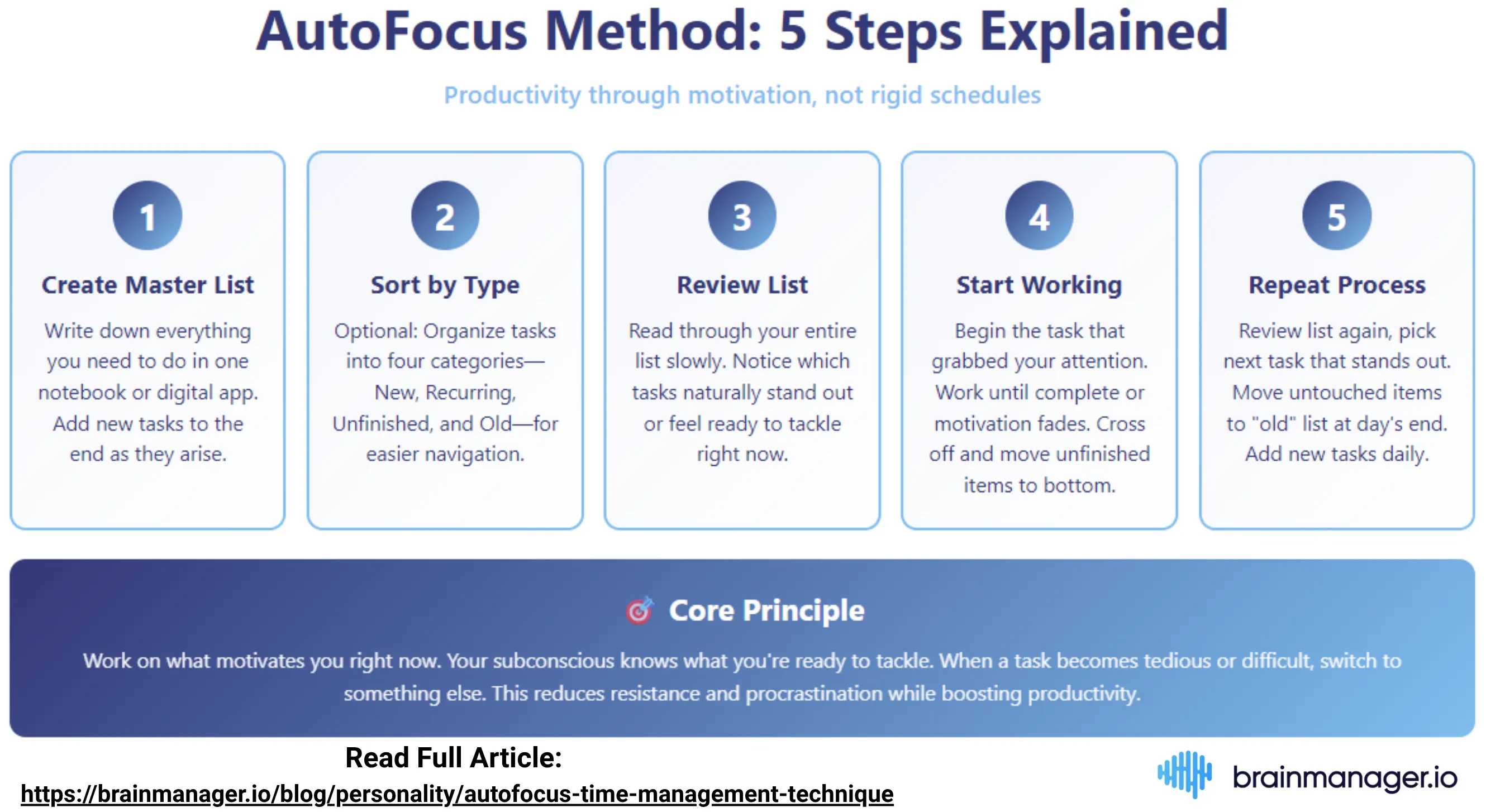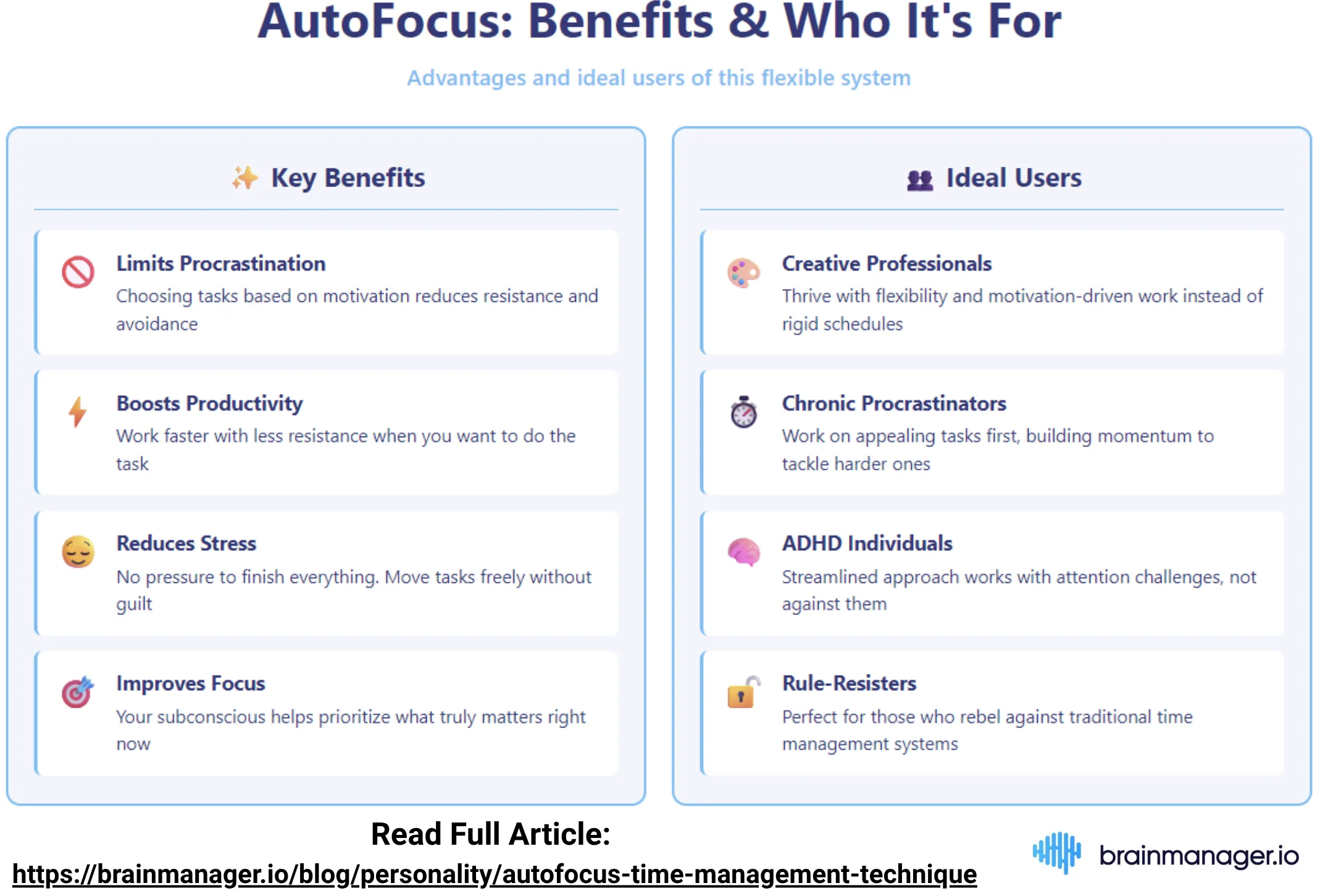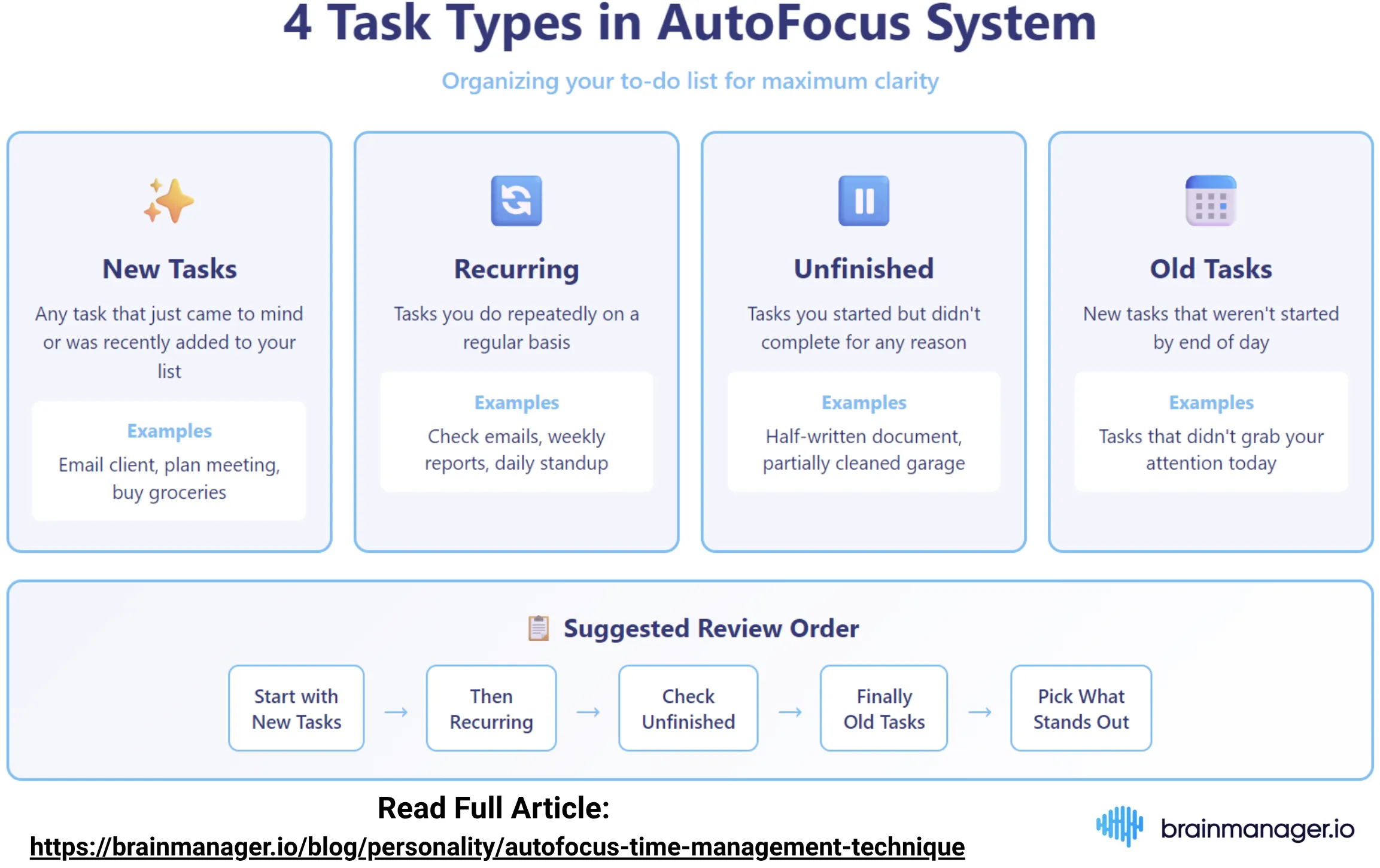How to Use the AutoFocus System – Flexible Productivity Tool for Creatives and Anyone Who Resists Rules
Effective time management is vital in today's fast-paced world, where inefficiency costs time and resources. The AutoFocus time management technique presents a simplified way to manage never-ending tasks and ensure productivity.


Back
9 mins read
The most common time management advice is prioritizing tasks based on their importance or urgency. But this approach can often lead to stress and burnout, especially when the tasks are complex, time-consuming, and do not yield tangible results.
So, how do you master improving productivity and performance without wasting time?
The answer lies with Mark Forster's AutoFocus time management technique, which is all about completing tasks based on your motivation. You're more willing to work faster, better, and less likely to procrastinate when performing tasks you enjoy. This, in turn, raises productivity and creates less stress while allowing you to focus on what's important.
This article covers how you can leverage the AutoFocus technique to get more done with less effort, thus supporting the Pareto principle, which states that 80% of our results come from 20% of our efforts.
What Is the AutoFocus Time Management Technique?
Many time management techniques advise you to prioritize specific tasks but never answer the "how." This introduces another problem of figuring out tasks in the order they need to be accomplished.
One of the most common ways of prioritizing is to focus on what is most urgent at the moment. There's also the other side of prioritizing — choosing the easiest tasks first. With either of these approaches, you may be ticking off tasks on your to-do list, but you're probably not impacting your personal or professional life much.
The second issue is that most time management techniques treat a to-do list like a full bucket that needs emptying.
The truth is that life is full of never-ending tasks. And as you tackle some jobs, others get added along the way. It can be overwhelming when you're constantly nervous about unfinished work. And this can lead you to an unsatisfying state of productivity limbo where you always feel like a failure.
Mark Forster developed the AutoFocus Method to tackle these two key issues. It uses motivation to boost productivity rather than focusing on tight schedules and deadlines.
What tasks do you wish to tackle first? People tend to work faster and with greater commitment when engaging in things they want to do. This technique encourages you to move to the next task that excites you when the current one becomes tedious, boring, or difficult to avoid wasting time.
Some time management advice will make you think you'll get caught up if you just work hard enough or have the right organizational tools. It would be best if you changed the analogy of your to-do list from a full bucket to a river with an endless stream of to-dos. You can't do them all, but you can choose what feels right now and go with the flow.
Adopting The AutoFocus Technique
The AutoFocus system has been modified over time but still has the same principle: create one long to-do list, review it, and do what comes to mind first. That being said, more structure is needed to keep the system effective.

So, here are more details about how it works:
Step 1: Create a master to-do list.
Think of everything you must do and write it down in a notebook. If you prefer using an electronic device like a Smartphone or computer, use a note-taking app or to-do lists software.
As new tasks come to mind, add them to the end of the list. Remember, you're just writing down your ideas/tasks in no order of urgency or importance.
This first step reduces the stress of remembering what needs to be done. Plus, it provides a physical record of tasks you'll be ticking off and readjusting as you go.
Step 2: Break down the long lists by task type.
This step is part of Forster’s “improved” Autofocus system and is designed for people who have a lot of “to-dos,” who find it challenging to manage a long to-do list, or who struggle to decide where to start.
There are four types of tasks we deal with — new, recurring, unfinished, and old.
This optional step involves breaking down your master list by task type. Take a look at your brainstorming list and determine which of the four categories each item belongs to. Create a new four-column list or use separate pages, placing each item in its appropriate spot.
- Any task that comes to mind is new.
- If you begin a task and don't complete it, add it to the unfinished list and get back to it later.
- Recurring tasks are those that you repeatedly do, for example, reading emails. Recurring tasks are put on your list each day and crossed out when finished, then they go back on the list for the next time.
- Lastly, any new task not started by the end of the day goes to the old tasks list.
In some ways, this system is similar to Kanban, where tasks are moved through a process based on activity.
Another option is to use four different colored highlighters, or you can mark each item with a letter or symbol representing the categories. This method is not as easy to visualize the different task categories, but it’s good for people who really don’t like the idea of writing the list over again (or who have a short list).
Step 3: Go through the list
Now that you have a master to-do list, you're ready to start. You'll need to go through your list at least twice. Ensure you read through it slowly and carefully while taking notes of the tasks that stick out the most in your mind.
What do you feel ready to do now? Forster says this is the heart of the AutoFocus system because whatever the subconscious helps you decide, you won't resist doing it. This, in turn, boosts productivity.
A simple guide is always to check the new task list first, then the recurring, unfinished, and the old task list, and repeat the cycle. This may seem contradictory — shouldn’t you start with the unfinished or old tasks first to get them done and out of the way? Maybe, maybe not…
Since you are going through the entire list, if an unfinished or old task is important and your gut says, “Do this,” go for it. But there’s a reason that they are unfinished or old. By starting from the “new” list as you review your tasks, you may find something that really inspires you to get going. Additionally, the new list may include tasks that were added because they have a higher priority.
NOTE: Some “purists” in this method believe you should work through each list systematically (time chunking would help here). This means you start working on new tasks, move on to recurring, and then unfinished before finishing with old tasks. However, we recommend looking over your entire list and doing what stands out to you most.
Step 4: Get started on each task that stands out.
Now comes the moment to get things done. Get going on whichever task you chose to start with. If you complete it, bravo! Mark it as done.
Lose motivation to finish? Need a break or have something else that requires your attention? Or perhaps you require assistance to finish?
Whatever the reason for not completing the task, cross it off and move it to the bottom of the “unfinished” list.
If the task was already in the unfinished category, you still cross it out and put it at the bottom. Not only does the act of crossing out an item provide a mental satisfaction that signifies you accomplished something, but you will be able to keep track of how many times you “started and stopped” a task.
The beauty of the AutoFocus technique is that you only work on a task for as long as you feel motivated. Let's say you set out to clean the garage, and after some time, you no longer feel like continuing. Write the task back at the bottom so you can return to it later.
Once you have appropriately marked the task — either as done or unfinished — review the list again to find another one that stands out. If you were simply taking a break, it’s up to you to decide whether or not to return to the previously started task or switch to something else.
Step 5: Repeat the process.
Repeat the process of slowly reviewing the list and completing tasks as they stand out. Anything not tackled by the end of the day goes to the old tasks list, and you can work on them the next day.
Since each moment or day comes with new tasks, this technique ensures you're always ticking something off.
Is AutoFocus Efficient?
Some might question the efficacy of the AutoFocus technique since it only encourages doing things you like. What about tasks you don't like but still need to complete, like filing taxes?
As mentioned earlier, the AutoFocus method is about completing tasks based on motivation. And many things can motivate you to begin and end a task or goal, including power, recognition and approval, reward and money, desire to win, visualizing the results, helping others, etc. In the case of taxes, the fear of getting a penalty from the IRS can be a great motivator to do them.
AutoFocus encourages users to combine reason and intuition so they can know how to do the right thing right now.
Benefits of Using the AutoFocus Method

The AutoFocus Time Management System approach is simple and easy to use and has several advantages, including:
Limit Procrastination
Because Autofocus encourages choosing tasks based on motivation, it is effective in avoiding procrastination.
Boost Productivity
Users of this method can complete more work since there's less resistance and procrastination.
Reduce Stress
It has been proven that effective time management is a powerful way to lower stress levels, and the AutoFocus method does a fantastic job of it. The planning process is much easier since it does away with due dates, priorities, and categories and creates one giant to-do list where you can work on anything you feel drawn to.
Also, working and completing tasks is more enjoyable when you want to do them. Lastly, there's no pressure to finish a job. You can write it in the unfinished or old tasks list and work on it later.
Improve Focus
The system relies on your conscious and subconscious minds to pick a task. If you go over a task and it doesn't jump at you, deep down, you know you really don't have to do it. Therefore, AutoFocus can help you improve your focus on prioritizing tasks that really matter.
Who Will Benefit?
The AutoFocus time management technique can work well in completing work, hobbies, and household chores. It benefits creative people who prefer to work on a flexible schedule. People are most creative when motivated by the work's interest, challenge, and satisfaction and not by external pressures.
Other groups of people who can benefit from this method are those prone to procrastination and poor concentration or who have ADHD. This method is more streamlined and will get such people motivated by working on tasks they enjoy.
As powerful as the method is, AutoFocus may have some limitations, especially when working with appointments and scheduled tasks like reports and meetings where you can't choose when to get them done.
And since this method doesn't rely on dates, it might be helpful to combine it with a calendar system to manage time-sensitive tasks like appointments and deadlines.
The Dos and Don'ts of AutoFocus Technique
Does this system seem too unstructured, with so many liberties to manage time effectively? Well, Mark Forster outlines some do's and don'ts to ensure the system works.
Do:
- Trust the system. At first, the system might seem unproductive, tackling tasks without a clear plan and doing what you feel like. But if you stay focused, you will be able to quickly cross tasks off your to-do list, motivating you to do even more.
- Use common sense. If there's an emergency, you should react to it immediately. Remember to put your current task at the bottom of the unfinished tasks list so you can return to it later.
- Create a calendar and set reminders to manage time-sensitive tasks.
- Remember to create your new list every day.
- Add new tasks to your list as they come up.
- Go through the list after an extended break to help your mind get an overview of what's pending.
- Incorporate other productivity methods until you find what works best.
- Use follow-ups and reminders to keep track of your work
- Include creative time on your list. Planning and brainstorming might not seem like real tasks, but they can be time-consuming. Plus, they allow for smooth sailing afterward.
Don't:
- Forget to create your master to-do list
- Use this system for tasks that need to be done at specific times
- Beat yourself up for not getting it right the first time
- Over schedule
- Compete with others
- Pre-edit what you put on your to-do list. The whole point of this method is not to prioritize in advance but instead to let the right task present itself.
Does AutoFocus Time Management Actually Work?
AutoFocus can be the latest weapon to help you take care of your daily tasks more effectively. This method encourages users to do things that really matter to them while balancing between urgent and important tasks.
People who use it claim that it has significantly increased the work they get done, reduced their stress levels, and accelerated routine projects.
Autofocus is just one of many possible techniques for tackling time management issues, and it works well for people who enjoy flexibility and don’t do well with repeated routines. Flowtime is another time management technique that can be used effectively with the AutoFocus system.
If you are someone who prefers more structure, the Getting Things Done method or Pomodoro technique might be more up your alley.
Judith Akoyi
Content Writer
Published 25 October 2025



